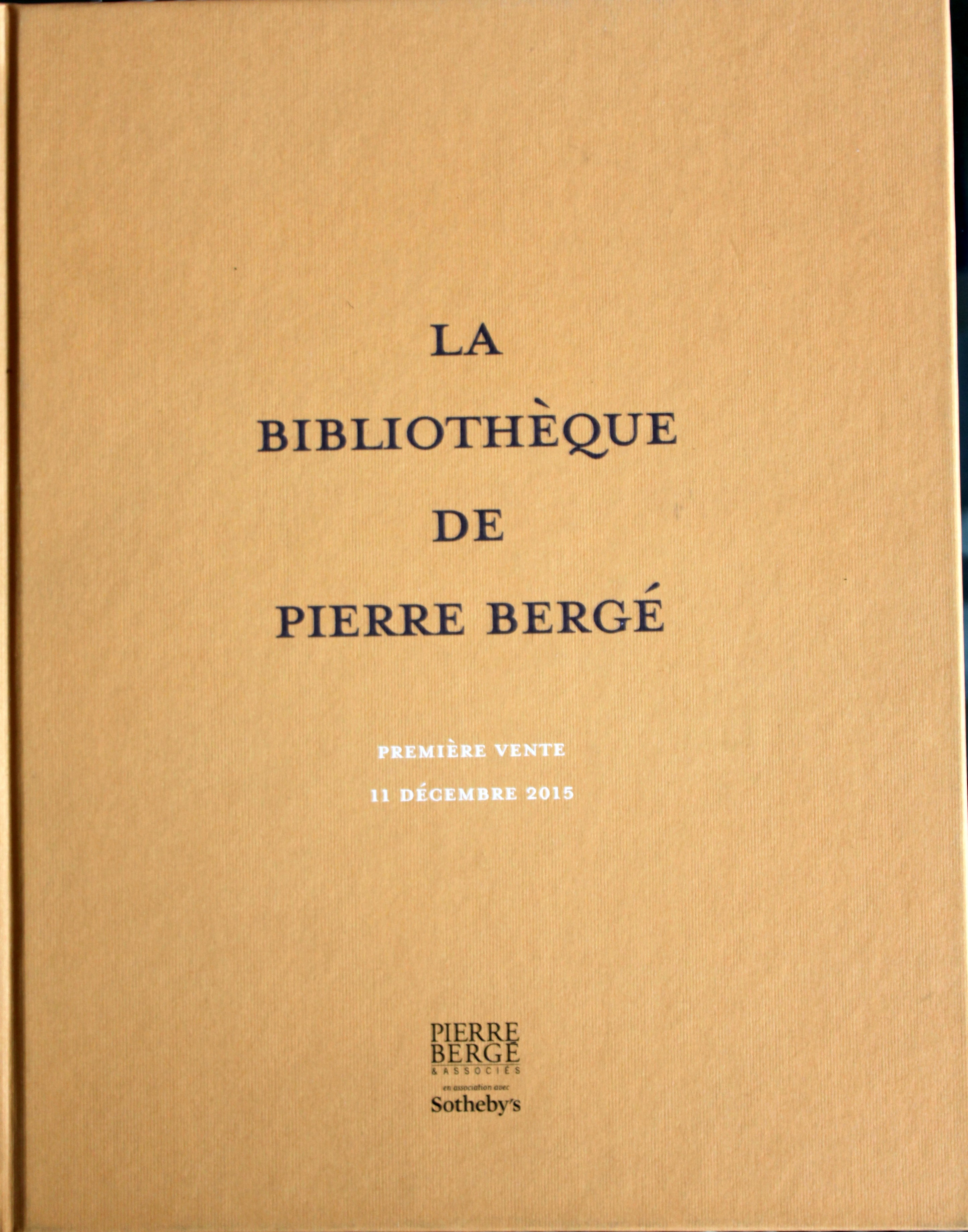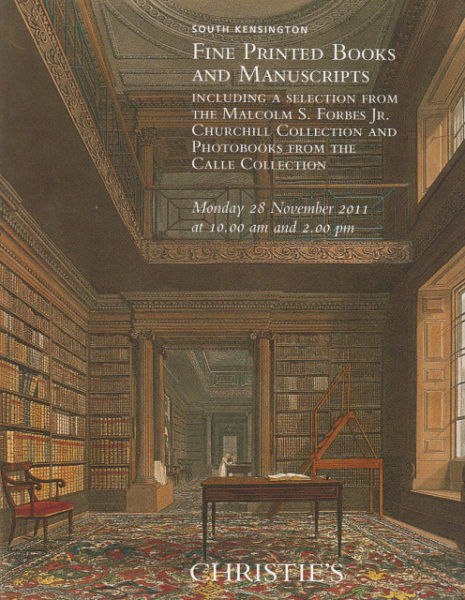Description
La Bibliothèque de Pierre Bergé
Pierre Bergé & Associés en association avec Sotheby’s
11 DECEMBER 2015 PARIS
HARDCOVER
188 LOTS
APPROX 350-400 PAGES
OVER 6 LBS.
erre Bergé has lived in the public eye for so long that most people probably think they know everything about his life as a succesful businessman and art collector. He first gained recognition in 1961, when together with Yves Saint Laurent he helped launch the designer’s namesake couture house; the pair would revolutionise the world of fashion well past the end of their romantic relationship in the mid-1970s. Their lives were so entwined until the couturier’s death in 2008 that the dispersal of their art and antiques collection a year later fetched $477 million for their eponymous foundation, solidifying their reputation as preeminent tastemakers.
Lesser known is that there was one field of collecting that Bergé pursued entirely on his own and quite privately. As a teenager he started amassing what would become an immense library of more than 1,600 precious books, manuscripts and music scores from the 15th to the 20th century.
“It’s a jardin secret,” Bergé admitted recently, a bit of a twinkle in his eye. Beginning on 11 December, with the first of six sales conducted by Pierre Bergé & Associés in collaboration with Sotheby’s in Paris, this secret garden will open to the public.
VOLTAIRE’S CANDIDE, OU L’OPTIMISME, [GENEVA], 1759, FIRST EDITION. AN EXCEPTIONAL COPY
PRESERVED IN ITS FIRST ARMORIAL BINDING. ESTIMATE: €80,000–100,000 (US$91,000–113,000).
The Bergé library extends from the early days of printing – including a first edition, published in Strasbourg in 1470, of Saint Augustine’s Confessions – to works by the Beats, such as William Burroughs’s Scrap Book 3, published in 1979. A “world library” with no borders between cultures that will attract the most demanding collectors, it contains treasures from the past six centuries, as well as an idiosyncratic array of Bergé’s favourite authors and bibliophilic coups de coeur. “This is a highly personal collection,” says Michel Scognamillo, one of the specialists organising the sale.
“It is not a complete collection, as Mr Bergé is not one of those collectors who says he wants an example of everything. But everything he has, he collected with his gut.”
As a result the offerings are a fascinatingly mixed bag. There are major pieces from the 15th century, such as a volume of Dante’s Divina Commedia, printed in Brescia in 1487 and embellished with woodcuts, and the Deifira, a dialogue on the art of love by the architect and humanist Leon Battista Alberti (Padua, 1471). Highlights from following centuries include the Sonetti, Canzoni & Trionfi, Petrarch’s seminal anthology of poems (Milan, 1507); a first edition of Montaigne’s Essais preserved in its first binding (Bordeaux, 1580); a folio copy of Shakespeare’s works (London, 1664); and a true first edition of Voltaire’s Candide (Geneva, 1759).
Although many historic works – as well as more recent ones – feature exquisite bindings, that was never the critical thing or the point of his collecting, Bergé explains. “For me, a paperback is as important as a rare or expensive book. What is most important is the writer, what the book says,” he notes, adding: “I am a collector, and you collect anything for more or less the same reason – you love the painting, you love the book, you love the writer. It’s not possible to collect a painter you don’t like or a writer you don’t like.” Bergé is adamant about this last collecting principle. “If I don’t like a writer, he’s not in my library. That’s very important to know,” he insists. “You want a name? Albert Camus is one. I like him not at all. He was not a great writer. He was a philosopher for schoolteachers.”
WILLIAM SHAKESPEARE’S COMEDIES, HISTORIES, AND TRAGEDIES, LONDON, 1664, THIRD EDITION.
ESTIMATE: €200,000–300,000 ($22,700–340,000).
Bergé’s singling out of Camus is telling: Before he became associated with fashion, right when Camus’s fame was at its highest, young Pierre aspired to be a writer and also worked as an antiquarian book dealer. Meeting Saint Laurent altered the direction of his path, but Bergé always maintained his bibliophilic passions, seeking out special volumes wherever he went. “I bought from dealers and at auctions around the world: London, New York, Madrid, Milan, everywhere,” he explains. Guided as he was by his early background, literary interests and many travels, Bergé assembled a library that was particularly abundant with treasures from the 19th and 20th centuries, including Charles Dickens’s personal copy of David Copperfield and Jean Cocteau’s autographed manuscript of Le Grand Écart, presented in an inlaid binding designed by Francis Picabia. Dominant in this group – indeed, in the entire library – is Gustave Flaubert. “He is my favourite writer,” says the collector. “He’s the greatest writer in any language or period. I have all the books Flaubert wrote, many examples of each.” Of Bergé’s numerous Flaubert volumes, the most notable is the large paper copy of Madame Bovary (first edition, 1857) that the author offered to Victor Hugo with the inscription: “Au Maître, souvenir et hommage” (“To the Master, my regards and homage”).
BLAISE CENDRARS AND SONIA DELAUNAY’S LA PROSE DU TRANSSIBÉRIEN ET DE LA PETITE JEHANNE
DE FRANCE, PARIS, 1913, FIRST EDITION. ESTIMATE: €200,000–300,000 ($226,000–340,000).
Prior to the auction, an exhibition of 60 selected items travelled to Monaco, New York, Hong Kong and London, a tribute to this particular master and his incomparable taste. In fact, the unveiling of these holdings may bring about what Saint Laurent once predicted, that “the world will talk about a goût Bergé just as it speaks of a goût Noailles.” Bergé himself admits, “The library was mine alone, and it is a mirror of my life, a self-portrait.”
As for his decision to disperse it, Bergé comments simply: “I am old – 85. I prefer to sell my collection so people who love the books can buy them.” Yet, he insists, “this is not a funeral.” It is a view the former Yves Saint Laurent model-muse and longtime friend Betty Catroux supports. “Don’t worry,” she says. “He will buy new books. Pierre is a man of the future.”


